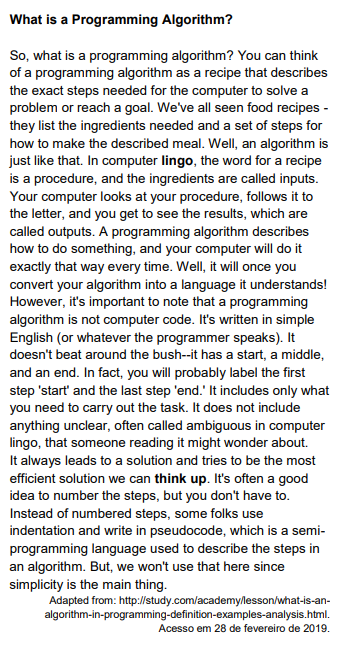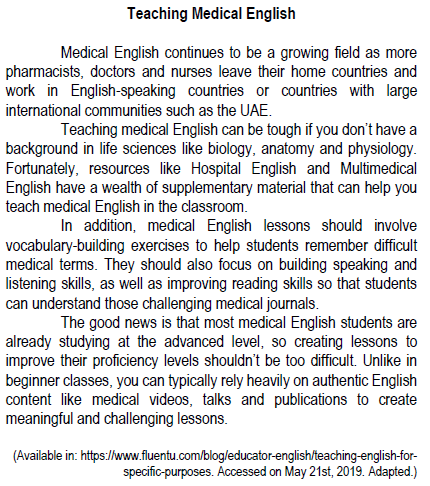
What can be inferred about the Medical English?
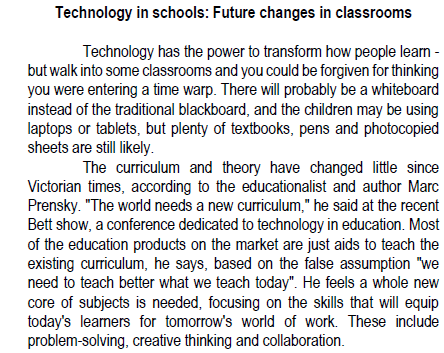
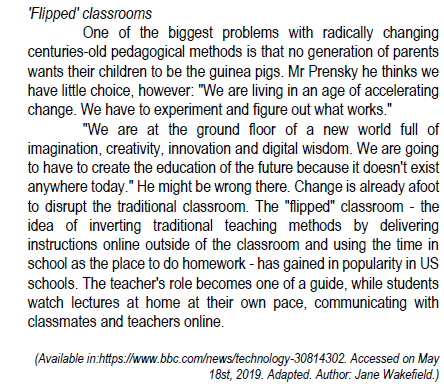
According to the educationalist and author Marc Prensky:
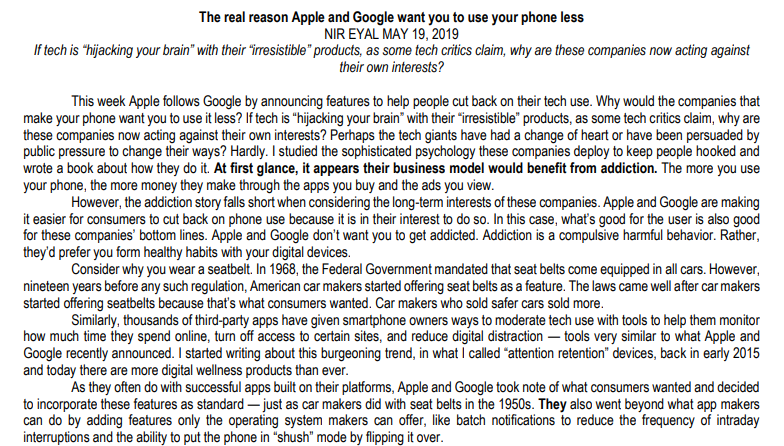

According to the passage, what can be stated about Apple and Google
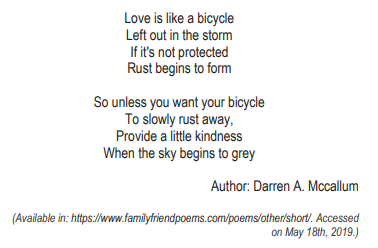
What is the best title for the poem?

What attitudes should teachers take when dealing with vulnerable children?
Segundo o texto, a implementação de algoritmos pode ser comparada a:
Literary texts can be used in classrooms as important sources for language learning. However, literature should not be presented only in order to highlight grammar structures or vocabulary, since literary texts, as social constructions, besides motivating students can also provide them with cultural knowledge and the experience of otherness. Literature through universal themes can develop empathy, creative thinking and sensitivity.
When introducing literary literacy as the appropriation of the text in its social use, Cosson (2012) develops a basic didactic sequence to approach literature in the classroom. Mark the alternative that corresponds to the steps of this didactic sequence in the order presented by the author.
Leia as afirmativas a seguir:
I. Está correta a grafia do trecho a seguir: to register oneself (alistar-se, dar entrada em seu nome).
II. O aprendizado de uma ou mais línguas não possibilita ao aluno o acesso a bens culturais da humanidade construídos em outras partes do mundo.
Marque a alternativa CORRETA:
Leia as afirmativas a seguir:
I. A avaliação deve acontecer contínua e sistematicamente por meio da interpretação qualitativa do conhecimento construído pelo aluno.
II. Está correta a grafia do trecho a seguir: to travel light (viajar com pouca bagagem).
Marque a alternativa CORRETA:
The following text is for question.

The text above tells the story of:
A imagem a seguir é referência para a questão.

After reading the billboard above, it is correct to infer that it is about:
The following text is for question.

According to the text, it is correct to say:
Text for the item.
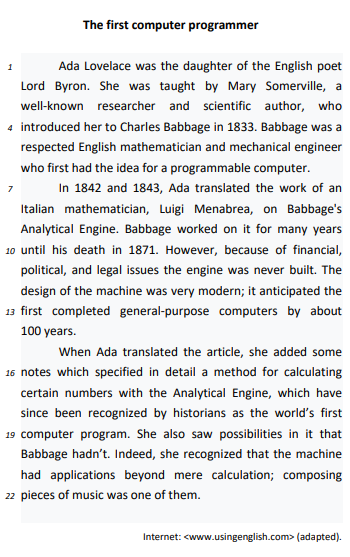
Based on the text, judge the items below. Apart from its inventor, nobody ever used Babbage’s Analytical Engine.
Text for the item.

Based on the text, judge the items below. Ada Lovelace and Charles Babbage realized that, besides calculation, the Analytical Engine could be used for other purposes.
INSTRUCTIONS: Read the text carefully and then mark the alternatives that answer the question or complete the sentences presented after it.
TEXT I
Using authentic reading materials in FLT
Let us discuss what reading in a foreign language is, how it differs from reading in one’s mother-tongue. If the foreign language learners are poor readers in their mother-tongue, we can’t expect them to read efficiently in the foreign language. But if they are good readers in
their mother-tongue, we expect them to transfer their reading strategies to the foreign language automatically. Unfortunately, this doesn’t always happen. Automatic transfer of reading strategies from L1 to L2 is difficult or never occurs. Good readers use top-down and bottom-up strategies to make predictions about the meaning of the text and check them. They vary their reading speed and strategies according to the purpose for their reading and the type of the text. When the same students read a text in the foreign language, they tend to use bottom-up strategies, i.e. their linguistic knowledge, but they rarely dare to use top-down strategies, i.e. their knowledge about the world. Appropriate reading strategies are rarely used and even some faulty reading habits, e.g. subvocalizing, regressive eye movements, etc., can be observed. So, foreign language students usually need more reading practice in order to become efficient readers in the foreign language. The use of authentic materials is an important principle of Communicative Language Teaching. In real life we read because we are interested in the communicative purpose of the text, in the ideas that the writer has expressed or the effect that the text is supposed to produce on the reader. The language in an authentic text is varied, whereas in a non-authentic one there is often one single structure that is repeated. The use of truly authentic texts is an important means of teaching students to communicate effectively.
Unfortunately, most textbooks make use of non-authentic texts. They are supposed to be easier than authentic ones and to be better suited to the students’ language proficiency level. However, this is not true because:
- non-authentic texts are usually over-explicit: they say too much because they lack the natural redundancy of authentic ones, they abound with details, so, the students are not given the chance to make any inferences;
- textbook reading materials usually deal with over-familiar topics. This can hardly be avoided at beginner level but at the higher levels the reading texts can be more informative, enjoyable and interesting;
- there is often a noticeable emphasis on the product of the activity, i.e. on the answers to the comprehension questions, over the process, i.e. the appropriate use of reading skills and strategies in order to understand the text.
We can overcome these shortcomings quite successfully if we provide supplementary authentic texts. Thus the language learners will become better readers, confident in their ability to cope with reading in real life situations.
So, why do we read? In our daily lives we read for two basic reasons: for pleasure and for information (Grellet, 1981:4). We read for information because we want to find out something, to learn something from the text, or for instruction, in order to do something with the information we get, to find out how to act. These reasons for reading are authentic. […]
Having mentioned the major drawbacks of textbook reading materials, let’s now consider the guidelines for selecting a text to supplement them or even replace them. These are the readability, the suitability of content and the exploitability of the authentic text (Nuttal, 1982:25).
- Readability means that the text should be at the right level. When we try to find a readable text, we have to assess the level of its structural and lexical difficulty. Still, we should not forget that the students can deal with more difficult texts, provided the task is not too difficult.
- Suitability of content means that the text should be interesting and informative. The students’ preferences should not be neglected and a survey of their tastes might help the teacher quite a lot.
- Exploitability means that the text should facilitate the development of reading skills in order to help the students become competent and independent readers.
However, we shouldn’t forget the fact that language classes are not entirely homogeneous: the level of the students is not the same, their tastes may vary and it is virtually impossible to create an ideal reader who could tackle all existing texts successfully. So, our goals and
criteria should be realistic.
[…]
What should be pointed out in conclusion is the vital importance of using authentic texts as supplements to textbook reading materials in order to prepare students for real life reading. Authentic texts foster the development of their reading skills thus helping them gain confidence in their reading ability in the foreign language. They become autonomous readers, who can take responsibility for their own reading.
Available at: <https://www.beta-iatefl.org/1106/blogpublications>.Accessed on: July 9th, 2019. (Adapted).
Some textbooks still make use of non-authentic texts because

